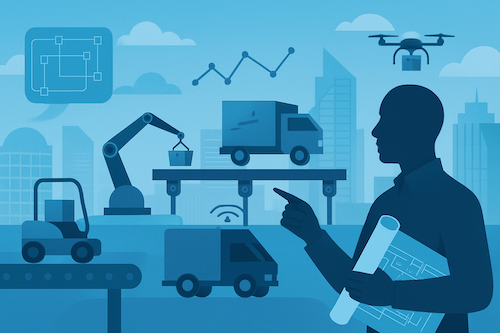
Table of Contents
In today’s commercial landscape, supply chain disruption isn’t an anomaly; it’s the new baseline. For years, enterprises have focused on building responsive supply chains. But what happens when the pace of change outstrips our ability to react? The conversation is shifting from reaction to prediction, leading to the rise of the autonomous supply chain.
While systems like SAP Ariba have revolutionized enterprise procurement (as we’ve discussed previously) and platforms such as Manhattan Associates provide critical end-to-end visibility (a topic I’ve also explored), architecting an autonomous network requires a different kind of digital intelligence. This is the space where platforms like Blue Yonder are making a significant impact.
From Automation to Autonomy
What do we really mean by an autonomous supply chain? Don’t mistake this for simple workflow automation. It’s a leap forward. Think of it as the difference between a player piano (automation) and a jazz musician improvising in real time (autonomy). An autonomous network is designed to sense, predict, and adapt to changes with minimal human intervention.
Insights distilled from numerous complex system deployments indicate this isn’t just about better forecasting. It’s about a few core capabilities working in concert:
- Predictive Demand Sensing: Using AI and machine learning to anticipate shifts in customer demand before they fully materialize.
- Intelligent Fulfillment: Dynamically deciding the optimal way to fulfill an order, factoring in inventory levels, logistics costs, and delivery times across the entire network.
- Cognitive Logistics: Continuously optimizing transportation routes and carrier selection based on real-time conditions.
These pieces are powered by a central cognitive brain. In Blue Yonder’s case, this is often their Luminate Platform, an AI/ML foundation that connects planning with execution. It acts as the supply chain’s central nervous system, processing countless signals to make decisions that once required teams of analysts.
The Architectural and Strategic Shift
A perspective forged through years of navigating real-world enterprise integrations suggests that the power of such a system lies in its unified nature. Instead of siloed applications for planning, warehousing, and transportation, platforms like Blue Yonder aim to create a single, cohesive environment. This integration is key, as a decision in one area (like a promotional forecast) instantly informs constraints and opportunities in another (like inventory and logistics).
So, what are the real-world implications for an enterprise?
First, there’s a profound increase in resilience. I’ve observed situations where a sudden port closure would have historically taken weeks of frantic phone calls and spreadsheet modeling to resolve. With this level of cognitive automation, the system can model and execute alternative routes in hours, sometimes minutes. The network learns to heal itself.
Second, the financial impact is direct. Optimized inventory means less working capital is trapped on shelves. Proactive demand planning reduces the risk of costly stockouts and lost sales. Dynamic logistics tames volatile transportation spending. It connects the physical flow of goods directly to the financial health of the organization in a very tangible way.
Redefining the Human Role
Does this focus on autonomy make human expertise obsolete? Quite the opposite. It elevates the human role from tactical firefighting to strategic oversight. Instead of manually re-routing shipments, supply chain professionals become the managers of the autonomous system. They set the strategic parameters, train the AI models, and manage the truly unprecedented “black swan” events that no algorithm could predict.
The shift requires a different skill set entirely. Supply chain professionals need to become fluent in data science concepts, understand machine learning model behavior, and develop the strategic thinking to guide autonomous systems rather than micromanage them. It’s less about knowing every SKU’s location and more about understanding how the entire network should behave under different scenarios.
The Implementation Reality
Longitudinal data and field-tested perspectives highlight that implementing such systems isn’t without challenges. The technical complexity is substantial, but the organizational change management often proves more difficult. Teams accustomed to manual control must learn to trust algorithmic decisions. This cultural shift can’t be underestimated.
Integration with existing ERP systems presents another layer of complexity. Blue Yonder’s platform needs to communicate effectively with everything from legacy warehouse management systems to modern cloud-based financial platforms. The data quality requirements are stringent because autonomous decisions are only as good as the information feeding them.
Ultimately, platforms like Blue Yonder represent more than just an incremental upgrade to supply chain software. They signal a fundamental change in how enterprises can and should manage the complex, volatile flow of goods, information, and capital. For any organization looking to compete in the coming decade, building this kind of predictive, self-correcting intelligence into their operations isn’t just an advantage; it’s becoming a necessity.
What are your thoughts on the feasibility of a truly autonomous supply chain? Connect with me on LinkedIn.